We are open and still on duty!
Our email and phones are still open and actively answered during COVID-19 pandemic and we are still on duty, performing all the essential electrical maintenance services (with PPE in place). Stay safe and if in doubt - give us a shout.
Mandatory Electrical Testing in England
Despite COVID-19 outbreak on 18 March 2020 The Electrical Safety Standards in the Private Rented Sector (England) Regulations 2020 were passed by the Parliament.
The new regulations require all landlords in England and Wales to arrange electrical inspection from qualified electrician and obtain (and pass to the tenant) a copy of Electrical Installation Condition Report (EICR) certificate for any tenancies created or renewed on or after 1 July 2020.
For pre-existing tenancies landlords will have to arrange EICR inspection and certification before April 1st 2021.
EICR inspection involves testing the entirety of "fixed" electrical installation within the property - from the fuse box/consumer unit, through all the socket, lighting and auxilary circuits to accessories, switchgear and pre-wired, non-portable electrical equipment (immersion water heaters, electrical wall heaters etc) - to make sure the entire installation is maintained to good standards and safe to use. Depending on age, condition and exposure to wear and tear inspecting electrician can issue EICR certificate valid for between several months and five years
Read more on IET site and then either call us or hit the "Quote" button on the top of this page to get your EICR booked with us. Our inspections start from £120 inc. VAT.
Spring 2020 Special offers
We have a few special offers for home owners, landlords and tenants in Kent:
Consumer Unit upgrades - replace your fuse box or upgrade your old consumer unit to the brand new, up to date, metal 18th Edition compliant consumer unit. Prices include tails, Henley and earth block where required.
We have three different offers with varying hardware levels:
BRONZE PACKAGE: a brand new Contactum or CP FuseBox metal clad, split load consumer unit with two RCDs (Residual Current Devices) and all the required MCBs:
A "Kia" of consumer units - good value, tested hardware, best choice out of budget brands
Split Load (2 RCDs) + MCBs up to 10 circuits - £480 incl VAT
Split Load (2 RCDs) + MCBs up to 12 circuits - £520 incl VAT
SPD (Surge Protection Device) to current regulations available from £70 extra
SILVER PACKAGE: a brand new MK Sentry metal clad split load consumer unit with two RCDs and all the required MCBs:
A "Ford Focus" of consumer units - dependable, recognisable brand with long history on the market, reliable hardware
Split Load (2 RCDs) + MCBs up to 10 circuits - £540 incl VAT
Split Load (2 RCDs) + MCBs up to 12 circuits - £580 incl VAT
SPD (Surge Protection Device) to current regulations available from £170 extra
GOLD PACKAGE: a brand new Hager metal clad, split load consumer unit with two RCDs and all the required MCBs:
A "BMW" of consumer units - German design, top of the line research facilities, solid performer
Split Load (2 RCDs) + MCBs up to 10 circuits - £620 incl VAT
Split Load (2 RCDs) + MCBs up to 12 circuits - £660 incl VAT
SPD (Surge Protection Device) to current regulation available from £150 extra
Upgrades to earth and bonding arrangements depend on a length and accessibility of gas and water pipes.
With the unit and accessories included, that's over a hundred quid off consumer unit replacement cost from the get go! Call us now on 077 9595 2000 or get in touch via contact page
Let there be light...
Recent works "at heights" to bring high volume LED goodness to cold and dark commercial unit.
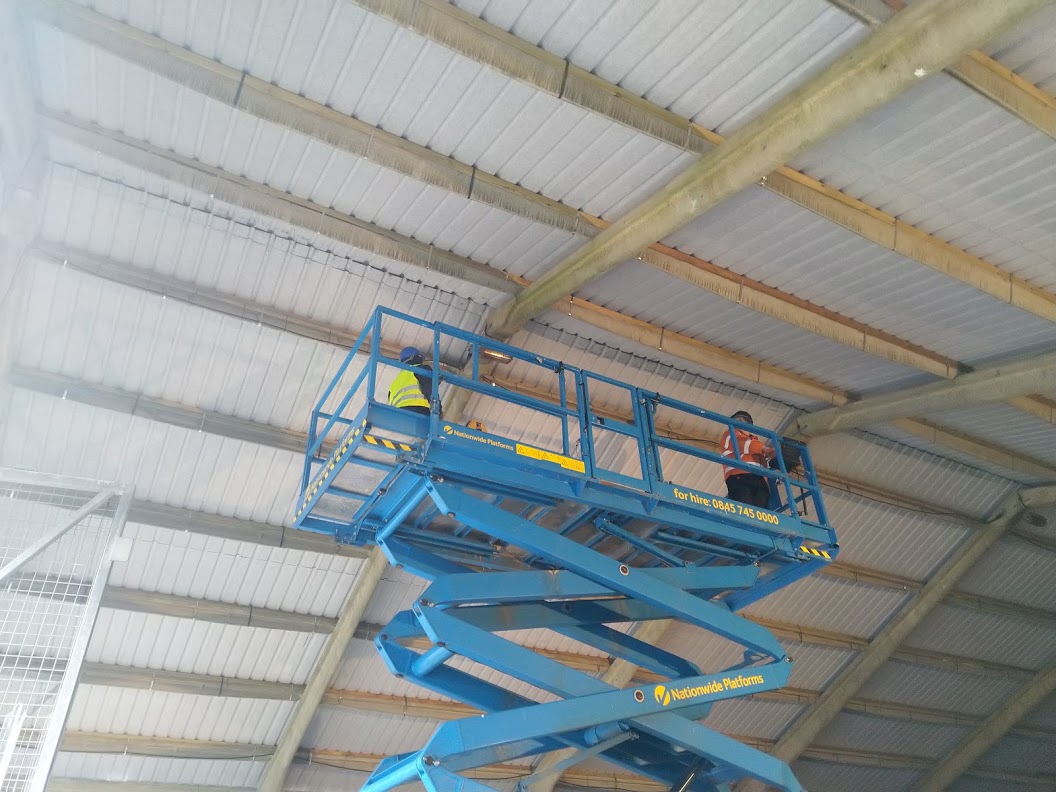
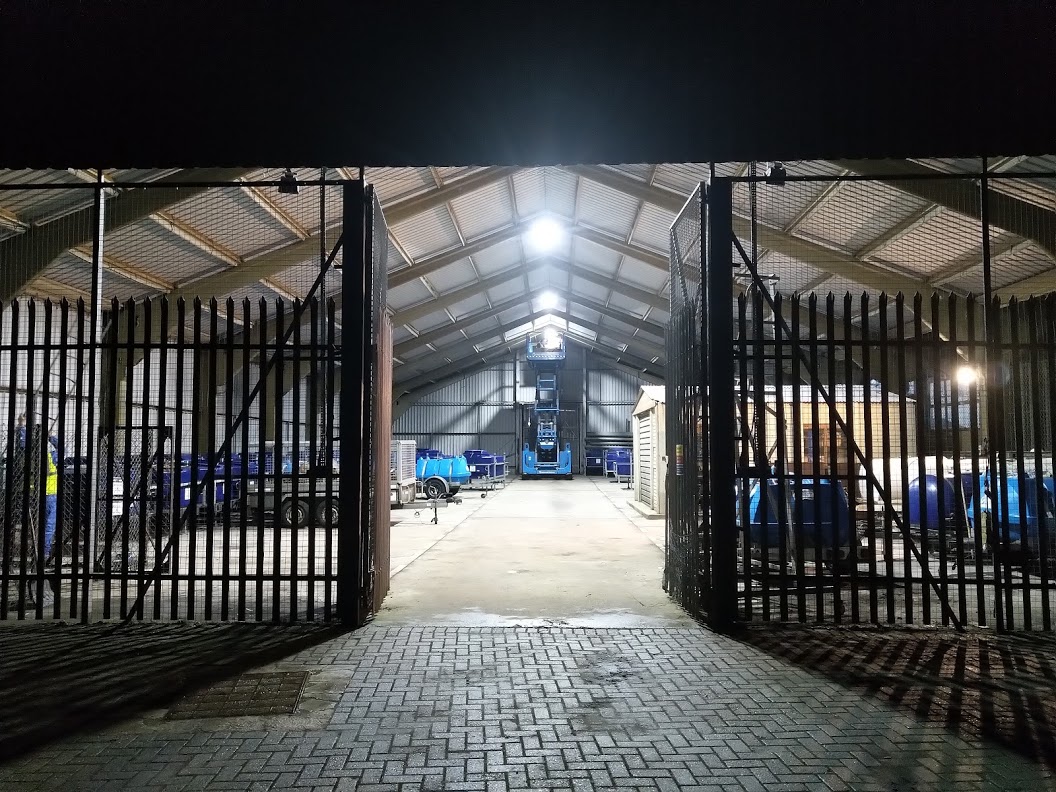
Surge Protection Devices
Following changes to IET Wiring Regulations in 2018 introduced regulation 443.4 which requires (except for single dwelling units where the total value of the installation and equipment therein does not justify such protection), that protection against transient over-voltages is provided where the consequence caused by over-voltage could result in serious injury, interruption of supply or affect large numbers of co-located persons or loss of life. This awkwardly worded excerpt simply means that from this point onward any electrican installing or replacing consumer unit should inform their clients that a Surge Protection Devices (SPDs) are available and may need to be installed in addition to consumer unit itself.
A Surge Protection Device (SPDs) is a component of the electrical installation protection system designed to limit transient overvoltages due to lightning or switching and divert the associated surge currents to earth, so as to limit these overvoltages to levels that are unlikely to damage the electrical installation or equipment.
Electrical installations in single dwellings occupied by the same family are currently not required to have SPDs installed, but are highly recommended to have one installed as any electronic equipment in your home may be vulnerable to transient over-voltages which could cause expensive and instant damage or significantly reduce an item of equipment’s lifespan.
Where over-voltage can affect more than one dwelling (for example HMOs) a surge protection may be required to be installed.
At The Resistance we will offer option to install SPDs with every consumer unit in 2019 and inform you of conditions and expectations steming from the new regulations.

Add some LED lights to your kitchen, for that winter mood...
Some LED strips over and under and undercounter LED lights to complement the furniture and voila - instant Xmas.
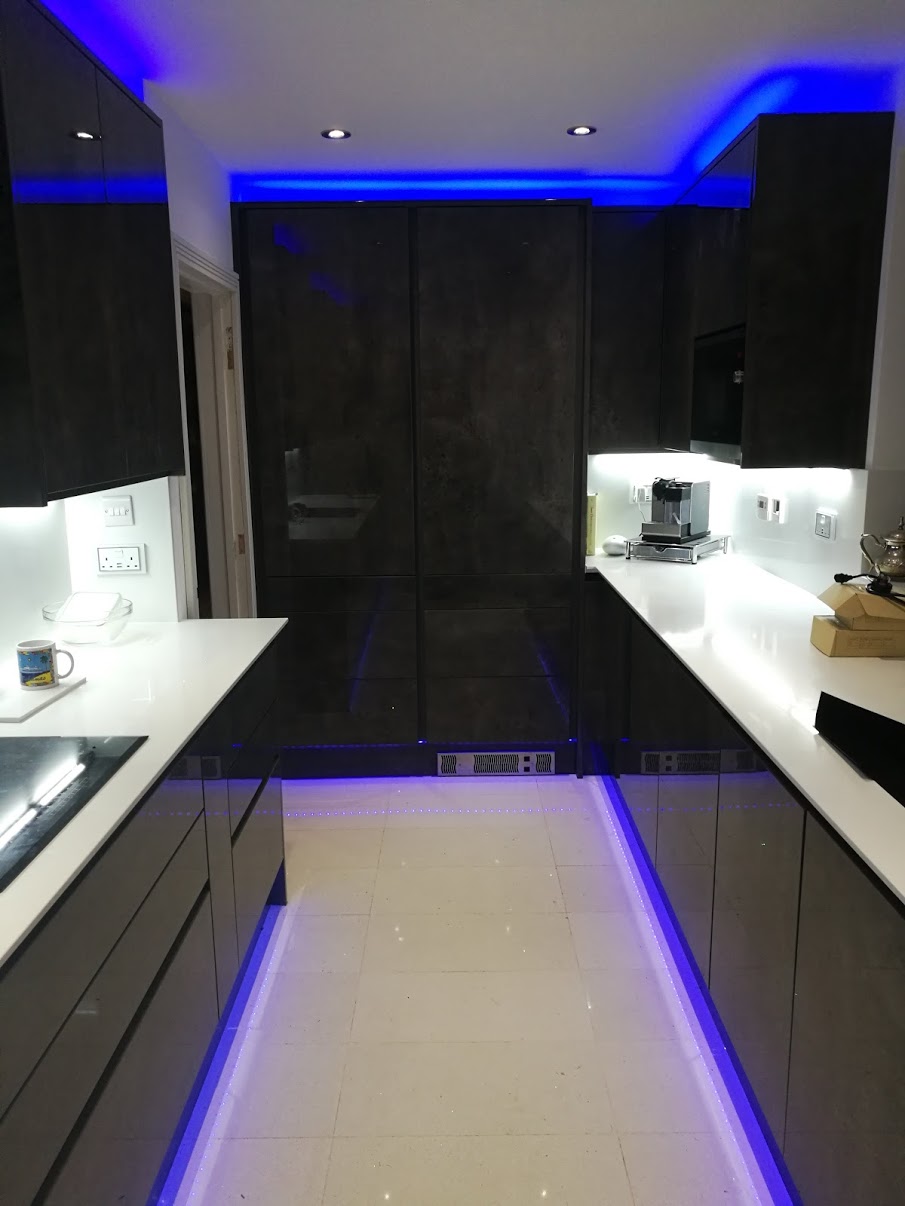
And this, dear landlords, is why you should get periodic electrical inspections...
During recent periodic inspection on a rented proprty things turned silly really fast. Bathroom with socket creatively positioned under the sink, right next to leaking water pipe wrapped with a gaffer tape and a night shade in the sink lighting up bath tub for "better mood"... Unbelievable.
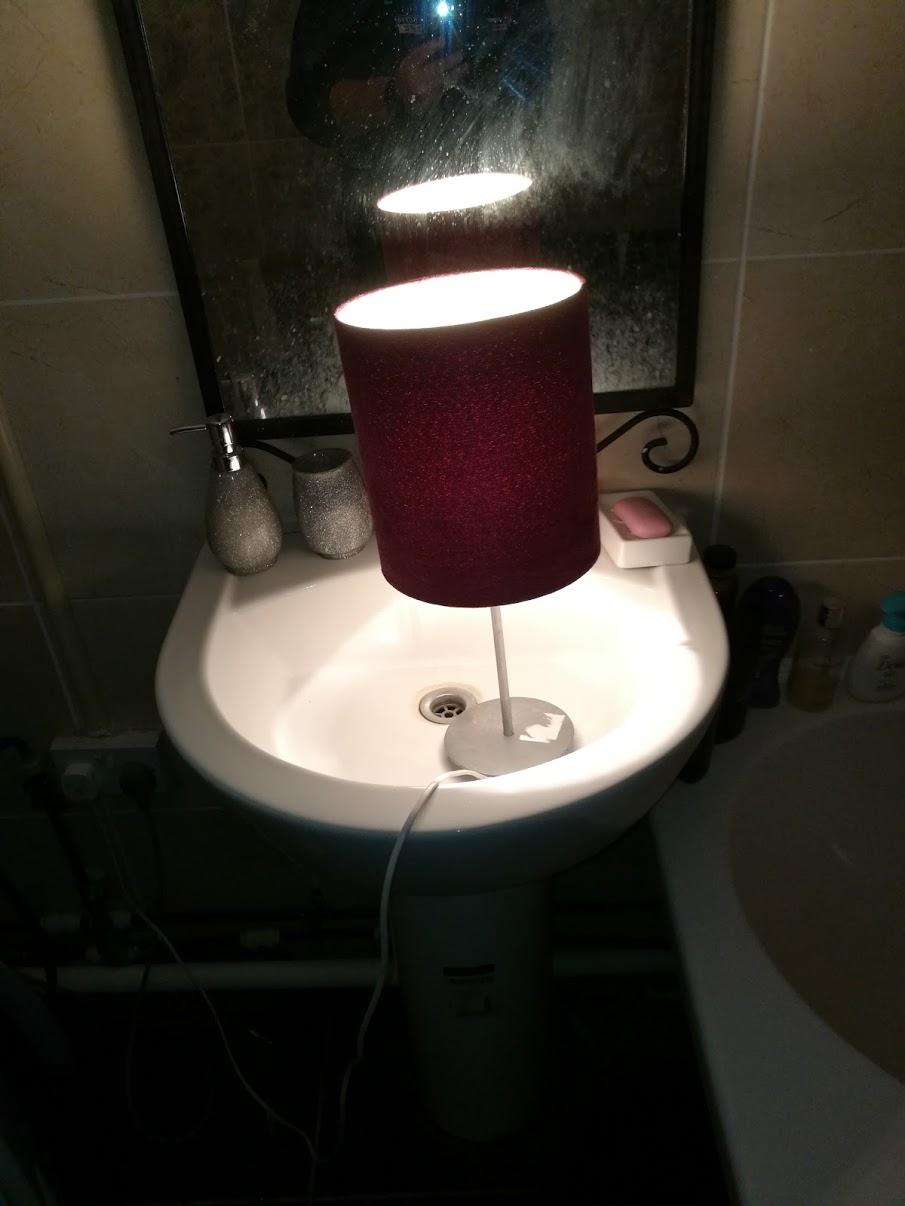
When boiler gets too hot
Yesterday attended a property in Essex where rodents gnawed through cabling. Exposed wiring, very old fuse box offered very little protection, one little fire starter managed to chew through the cable and close the circuit with its body and the whole cable turned into one giant heating element with copper core glowing red hot within seconds... Owner swiftly disconnected power manually, but that was a close call - incredibly lucky.
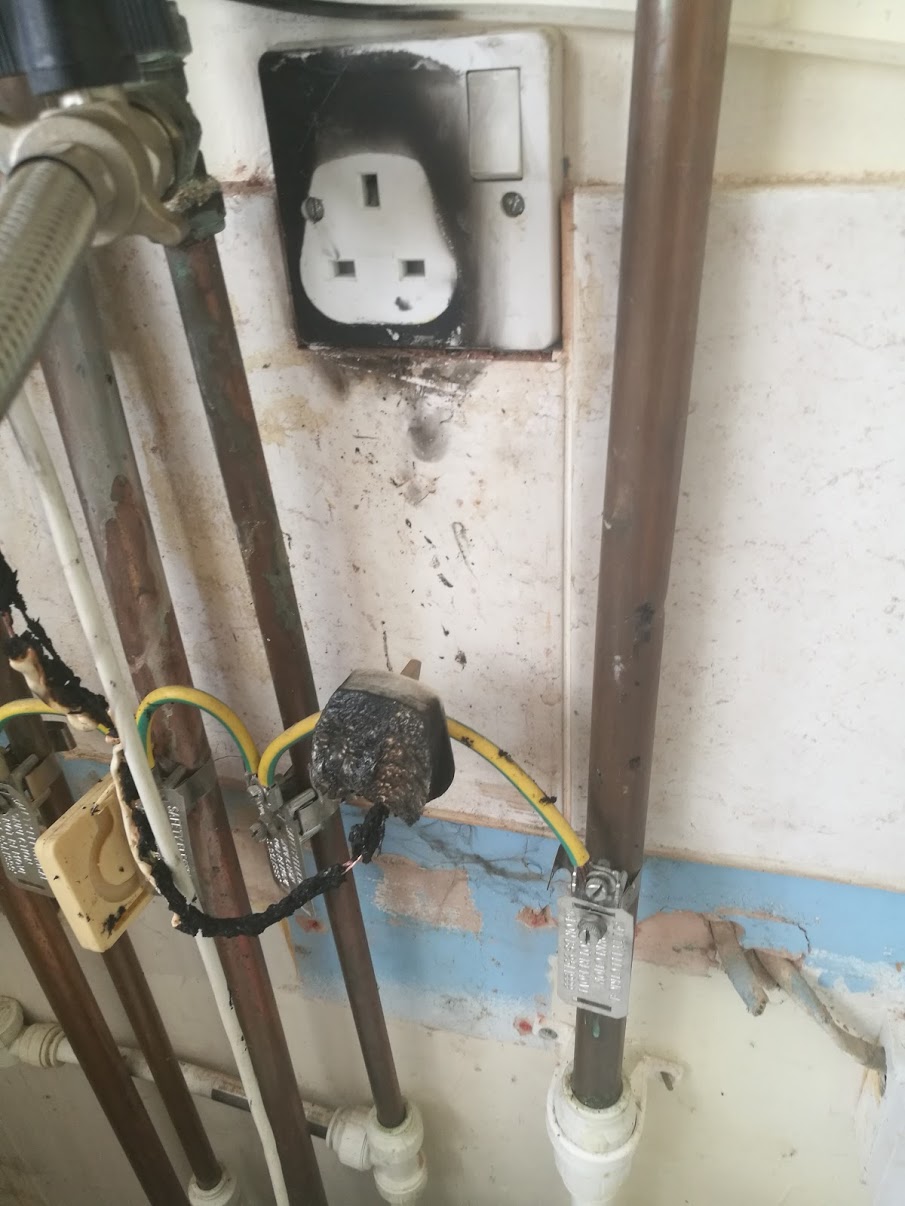
May 2017 Special Offers
/OFFERS NOW EXPIRED/
Safety first
As it’s April Fools today I’ll share another “ingenious idea” implemented few decades ago by the kitchen installers in one of the flats I recently inspected: “when you run out of green and yellow earth sleeving - don’t worry - simply grab any off cut cable from the floor and use the outer sleeving instead. Or penne pasta. Or whatever you find in the cupboard really.”
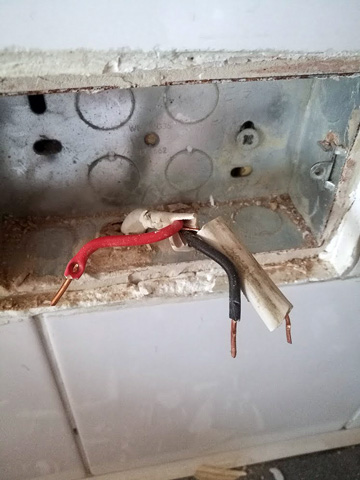
Another phoenix
Found during inspection of a two bedroom flat in Walthamstow. Resourceful tenant done really odd things to the installation for months (including use of light pendant as means of powering electric heater via some sort of Edison screw to three prong plug converter found in local corner store), then used random wire gauges to prevent fuses from tripping:
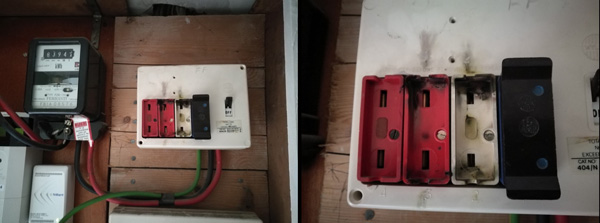
The old consumer unit was upgraded to the new British General Amd 3 metal unit with RCBOs, all overheated wiring replaced, all the lighting circuits updated to energy saving LEDs and the entire installation tested top to bottom.
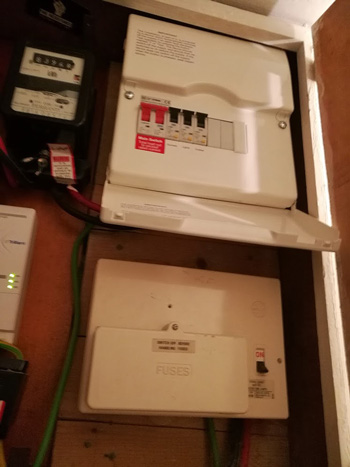
The things I find at work - March 2017
As an electrician I encounter incredible displays of Darwinism in action several times a week. It never stops to amaze me just how incredibly lazy people can get while installing electrical equipment in domestic premises. Below are two pictures of electrical connection found this week in a London flat and left behind kitchen furniture by some truelly ingenious and super laid back “professional” individual at some point in the early 2000’s.
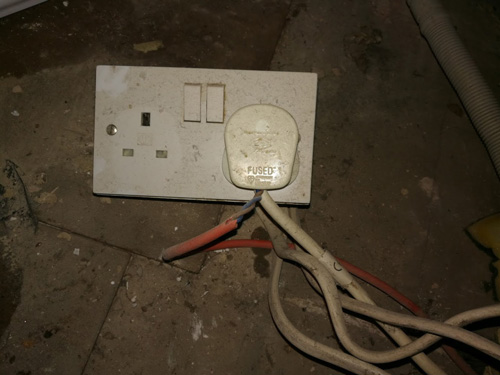
The contraption pictured consists of a 2.5mm2 spur borrowed from ring mains in a bedroom, going into the back of a pattress with double socket fastened to it. The socket itself served as a junction box spurring into additional two radials - one serving fridge, freezer, dishwasher, washing machine and microwave and one serving all remaining kitchen sockets. So far so good. But when the installers discovered they forgot to connect cooker, hood and oven they decided to use the socket on the front to supply those too.
They must have run out of 13A plugs in the process, so they wired two flex cables: a 5m long 1.5mm2 extension lead and some random 1mm2 unearthed flex to one and the same plug and thusly powered the reminder of the kitchen appliances for the years to come. Without thinking much, they then hid this ingenious “one socket serves them all” implement under the kitchen sink where it waited in a growing wet patch of water leaking through old silicone for the inevitable to happen… Interestingly, it also looked as if at some point in the last 17 years someone “serviced” this “dual plug” by changing blown fuse inside…
How is that for regulation 526.3 “maintenance free connections” in inaccessible places? Look under your kitchen furniture for various horrors of yesteryear.
Upgrade your consumer unit
There are over twenty million electrical installations in domestic dwellings in the UK with electricity meter and consumer unit arrangement supplying the lighting and power in the property.
Every year there are numerous fires due to faults and wear & tear in domestic environment. The Amendment No. 3 to BS 7671, published in 2015 and “in force” since January 2016 introduced Regulation 421.1.201 in order address these issues and to increase the safety of consumer units and similar switchgear.
Regulation 421.1.201 requires that consumer units in new installations or where consumer units etc. are being replaced, shall have their enclosures made of non-combustible material, or be enclosed in an accessible cabinet or enclosure itself made of non-combustible material.
In short, all cosumer units installed after January 2016 must have their enclosures either made of metal or be encapsulated in additional metal chassis to prevent fueling the flames in the event of a fire.
Although it is NOT a requirement that all older non-compliant ‘combustible’ consumer units and switchgear must be replaced – instead, lanlords and tennants are encouraged to arrange an inspection of a domestic dwelling’s electrical installation by a competent person who will help them to make a decision as to whether the consumer unit and any associated switchgear are still safe and suitable for their function. Such a decision would be informed by the age, condition and installation circumstances of the domestic dwelling’s electrical installation.
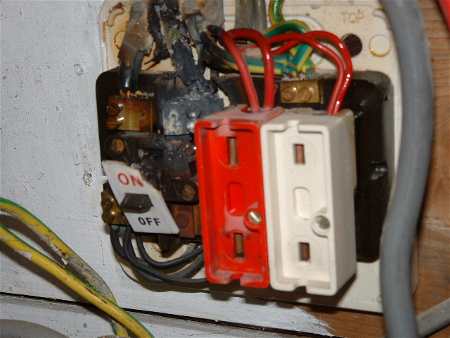
If you are concerned by the age of your consumer unit and live in Medway area The Resistance is currently offering “peace of mind” quick inspection services to landlords and tenants. And having never charged for unnecessary services - it is my personal promise that if your consumer unit is in good state and doesn’t require upgrading - you will be told so without any sales pitches. Our full Electrical Installation Condition Reports (EICR) start at £95 for a flat dwelling and consumer unit upgrades start at £290 including Amd 3 compliant, RCD equipped branded unit (British General, Hager or MK depending on size required).
Use contact form or phone details from the navigation bar above to get in touch.